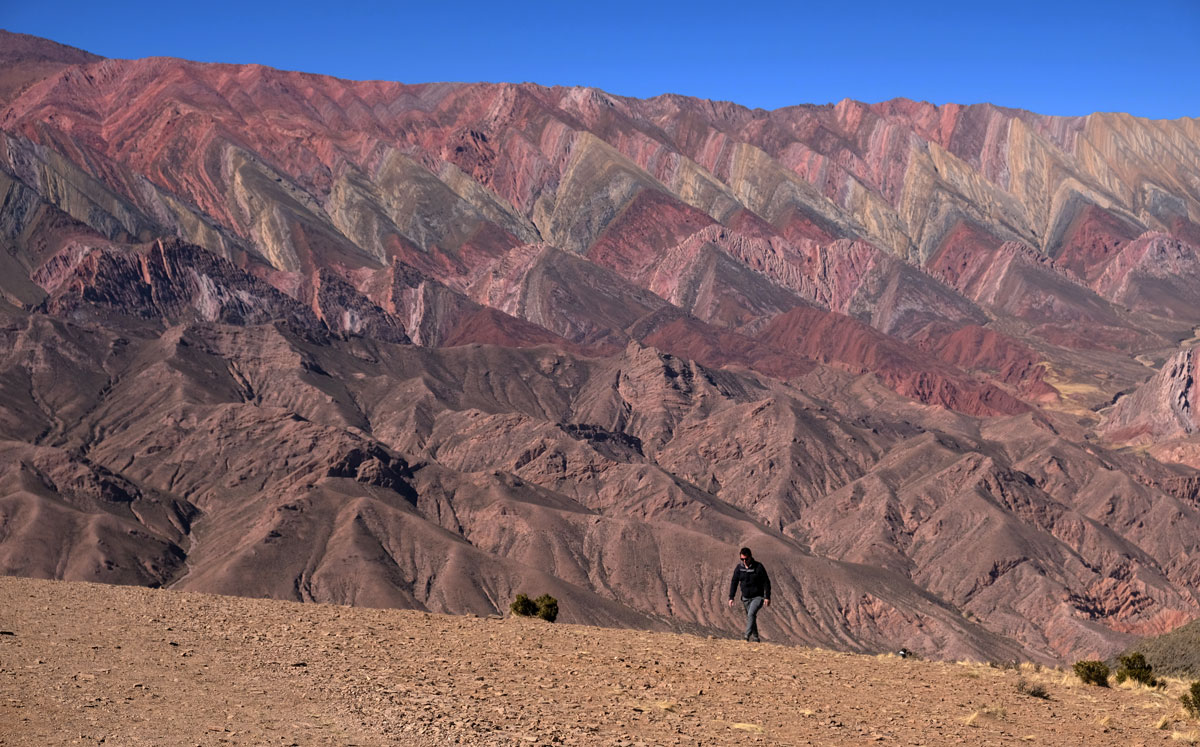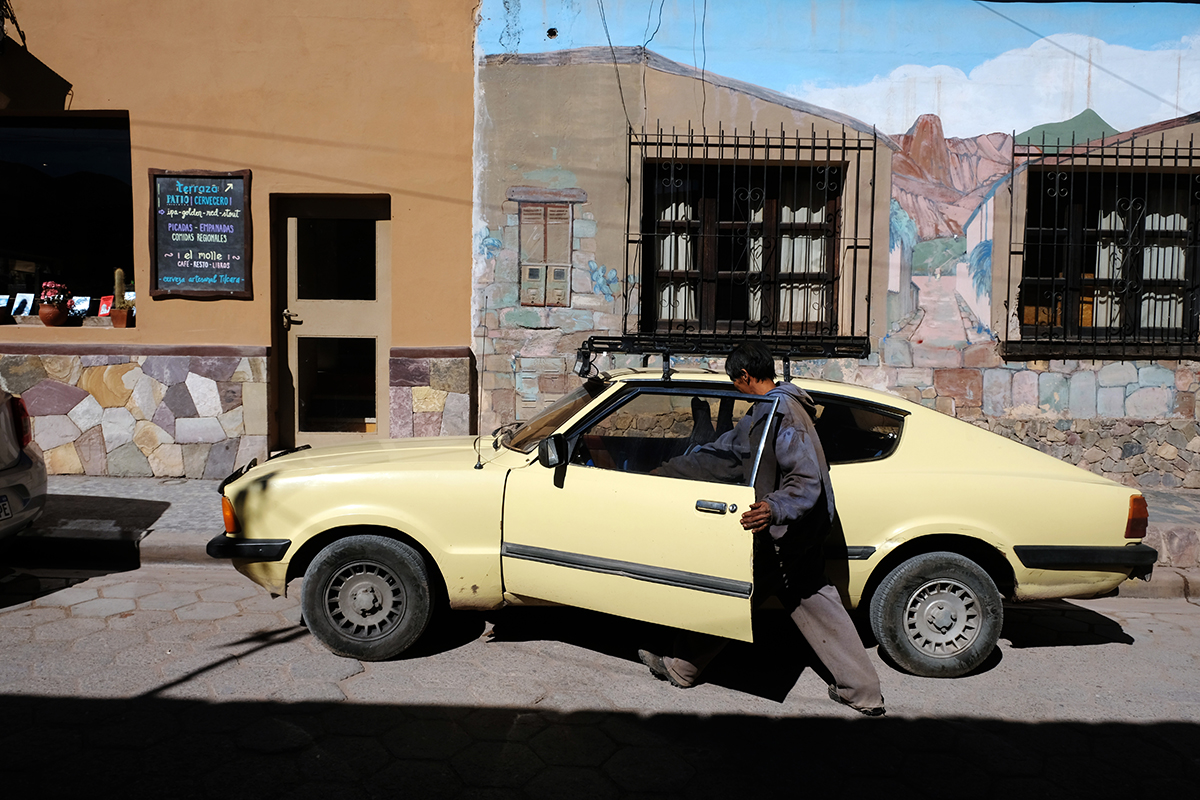Takes my breath away – A tour in the Argentinian Andes
This Monday morning I am sitting in the breakfast room at Hostal Sonada in Humahuaca (pronounced “oomawuaka”), an old town of a few thousand inhabitants in Quebrada de Humahuaca, a narrow mountain valley located in the province of Jujuy in north-western Argentina. They play what I would call native South American music over the speaker. Including El Condor Pasa. There is only one other family of four sitting in the cosy room, where there’s a heater to warm up my cold fingertips.
It’s July, it’s out of season, and the sun only gets up at 8 am, but the temperature now is minus 1. During the day it gets up to 20 degrees. Last night I bought a small woollen hat to protect my sensitive head from the strong sun and the cold mornings and evenings. I’m at 2,993 metres above sea level according to my altimeter, and 23 degrees south and 65 degrees west
The villages in this area look like they’re pulled straight out of a postcard, I read in the internet before I came here. And rightly so, the dusty streets are lined with old stone buildings, mostly with vendors selling woven handicrafts. This red-earthed gorge is filled with colourful mountains. Today I am out looking for Humahuaca’s famous 14-coloured mountain, something that looks like a giant Swiss marble cake.
The most exciting view of these famous coloured mountains called Serranía de Hornocal are on a natural viewing “platform” about 25 kilometres to the east of the town Humahuaca. It is a limestone formation that extends well into Bolivia and Perú.
The road that takes you there is a dusty gravel road that towards the end climbs up to 4,350 metres above sea level through a series of hairpin bends. Gravel roads come in various qualities; this one is not too bad though a bit bumpy in some stretches. At times I felt I was driving my rented Nissan March across a washboard. I left my hotel in the early hours and traffic was sparse. The area is without mobile access, so anything worse than a flat tyre I would be stuck under the scorching sun. I thought.
After one hour of slow driving I reached my destination, paid the entrance of two dollars, and drove up to the car park. There were already a few visitors there, enjoying the stunning view. But an even better view, a real revelation, emerged at the end of a 350 metres long path down a steep slope – at the edge of big hill. Walking down and back again was hard breathing for a nearly 70-year old man. It literary took my breath away.
According to Wikipedia, this region has always been a crossroad for economic, social, and cultural communication. It has been populated since the settlement of the first hunter-gatherers, which is evidenced by substantial prehistoric remains. It was a caravan road for the Inca Empire in the 15thcentury, then an important link between the Viceroyalty of the Río de la Plata and Viceroyalty of Peru, as well as a stage for many battles of the Spanish War of Independence. The Quebrada de Humahuaca was made a UNESCO World Heritage Site in 2003.
As I returned after an hour and a half, a caravan of visitors was on its way along the dusty road towards the sightseeing area. It pays to get up early …
The next morning, I was out early again. Today’s destination is Iruya, a small town (population 1,000) singled out on travel pages for its 16th century church and its layout. Pictures on Google show a town virtually hanging on the mountain side.
After tanking up for one thousand pesos I was heading north on Ruta Nacional 9, accompanied by Donkeyboys (a Norwegian pop band) on my iPhone. After about 35 kilometres I left the highway and I was on to a gravel road again. At first it looked like a washboard and felt like one. It was going to be 53 km on low gear. But I’m not one to complain, having been on dirt roads in Nepal and Laos. After about five kilometres I reached the first village and the road seemed to disappear into a river. Tracks showed that it was manageable, even though some of the water had frozen to ice during the night and had not yet melted.
A little after half way I crossed a mountain pass at 4,000 metres. A couple that had set up shop selling local handicrafts looked like they were freezing. After the mountain pass the road went steeply down with hairpin after hairpin after hairpin for nearly 20 kilometres. I finally reached the town after three hours of driving. Now I had about two hours for lunch and looking around before returning. I had to get back before it got dark.
The next day I relocated to another town called Purmamarca, around 70 km south of Humahuaca, a stepping point for trips to the salt lakes – Salinas Grandes. On the way down I wanted to stop in a few smaller towns for lunch and to get a feel of the local atmosphere.
First stop was Tilcara, a town where human habitation date back more than 10,000 years, according to Wikipedia. Thus, making it one of the oldest continuously inhabited settlements of Argentina. The area features dramatic mountainous landscapes and rich aboriginal traditions, but so does all the settlements in this area. It seemed a major tourist attraction, but with mostly domestic tourists – at least from what I can see. Minimal English spoken.
First challenge was to find a safe place to leave the car when walking around soaking up the small-town feeling. After driving around for a few minutes, I found an Estacionamiento con tarifa. But no warden to be seen so I could pay for my parking ticket. As I spotted the tourist office just a few blocks away I went in to ask. Someone who spoke English wanted to help me locate the parking warden, bus as no woman with a green jacket was found, he wrote me a note with official stamp and signature I could put inside the front screen so that any fine or tow-away could be avoided. Awesome service. He was probably amazed by someone who was honest and concerned about doing things right.
The lunch I had was not so awesome, but it did fill my stomach. After Tilcara I was on to my destination, another 25 kilometres away. Road is good, but the driving on the roads in Argentina is anything but good. I keep to the speed limit all the time, even in build-up areas where one was supposed not to hurry away above 40 km/h, but I was overtaken all the time. By cars, buses, and heavy trucks alike. Also, the Argentinians drive too close for comfort, sometimes so close I can hardly see their headlights in the mirror.
After arriving I settled down in a restaurant in Purmamarca for a cup of coffee before checking in to the hotel. Live music at half past one in the afternoon. Two musicians, one playing the flute and one the guitar, played El Condor Pasa and Sounds of Silence while I was enjoying my café sin leche.
Purmamarca is a dusty little town with a population of around 2000 souls according to several sources on the internet. All activities are centred around the town square in front of the church, Iglesia de Purmamarca. Locals, most of Native American origin, are trading local handicrafts and typical Andean garments. Nestled between steep colourful mountains the town is picturesque in its own right, but it is clearly that tourism is the main industry. There are lots to see, both around here and further up the valley.
My hotel, El Amauta Hosteria, is not cheap by local standards at 90 dollars a night, but is located at the top of the village with a fairly good view of the town and the valley. However, their WiFi is lousy and there is very little hot water in the tap. Overpriced, someone might argue.
I’m trying llama meat for lunch. Cazuela de llama con arroz. To go together with Salta Rubia, a 500 ml lager beer called cerveza pequeno. At Restaurante Marito. Also accompanied by Andes pop, or whatever you call native South American inspired music. The dish took some time to prepare. As all dishes in this part of the world, it also came with potatoes. To me, it tasted like something between beef and mutton, tender and quite mild in taste. The llama is a domesticated South American camelid, widely used as a meat and pack animal by Andean cultures since Pre-Columbian era, says Wikipedia. A full-grown llama can reach a height of 1.7 to 1.8 m at the top of the head and can weigh between 130 and 200 kg. Almost about my size.
The next morning, I was ready to leave around 09:20 but had to scrape off the ice of the windscreen first. Temperatures here are above twenty during the day but goes down below freezing at night. Google map says it takes one hour to reach the salt lakes. But what does Google know? Google doesn’t know about heavy trucks trying to negotiate the steep hairpins, slowing the traffic down.
At 10:45 I stopped for coffee at La Pekana, a truckers’ diner around 15 km before the popular Salinas Grandes spot. The guy was just about to open the shop. The sun is harsh at this altitude, and the air is very dry, drinking coffee is probably not the smartest thing to do.
I had already passed the highest point at 4,170 metres and done with all the hairpins, so the road forward was fairly straight on top of the plateau. I could definitely feel that lower oxygen level, especially when I moved about. I realised I don’t have the lungs of a Sherpa.
Half an hour later I arrived at the salt lake. Highway 52 – which continues all the way to Chile – is a well-maintained road that goes straight across the salt flat. Halfway across the flat is the parking spot, and there were already some visitors and locals selling handicrafts and bits of salt and other minerals. No charge for seeing the flat, but a ten pesos fee for using the lavatories. Most visitors were busy taking selfies.
The Salinas Grandes is a large salt flat in Northern Argentina at 3,450 metres above sea level, spanning several provinces. It is a tourist attraction, though not as famous as the one in Uyuni in Bolivia. A salt flat are expanses of ground covered with salt or other minerals. They are found in very dry climates and are natural. When the rate of water evaporation exceeds the rate of precipitation, minerals accumulate on the surface.
After being busy taking pictures of people taking pictures of each other it was on to restaurant El Solar, 13 km further away for possible lunch. Closed. But I found Rambo restaurant, run by señor Adolfo Chaves, a bit further along Highway 52. No food, but chocolinas biscuits and coffee sin leche. 80 pesos.
But there was WiFi at 0.87 Mbit/s. But no one around here on Grindr.
[August 2019]

